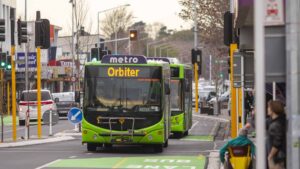The plan – what does it mean?
You may think: “Surely, we’ve got to do something about climate change; isn’t this the way forward?” And that’s the crux of the matter. Yes, climate change should be at the forefront of all decision making. Greater Christchurch’s public transport proposal will make little difference on that front. Hence my disappointment.
Greater Christchurch Public Transport Combined Business Case

In short, it is proposed to beef up bus-based public transport, mostly in Christchurch with some improvements in Waimakariri and Selwyn. The name of the study is “Greater Christchurch Public Transport Combined Business Case”, and this was signed off by CCC and ECan on 10 December 2020.
It sets out what is supposed to happen until 2028 and what effects that will have. Collectively, we’ll be spending $115m during that time and it concludes that this will improve quality, quantity and reliability of buses, resulting in higher bus use. And that we’ll thus save some car journeys and emissions (13 million fewer kilometres driven annually by 2028).
Less congestion and fewer emissions by 2028 must be a good thing? That’s at least the implied message. What the report doesn’t tell you is that under this plan by 2028, we will have more congestion, and our transport emissions will have increased. Hence, I told the journalist who rang me that the plan is “really, really unambitious” and in fact, I’m quite upset that the authorities don’t have the guts to tell the public that emissions and congestion will continue to increase.
A core component of the plan is to have buses run more frequently and make them more reliable. And that is a necessary first step and of course, all elected members ought to have voted for it (the usual suspects at CCC didn’t). What the plan isn’t doing is where my concerns lie.
Why this plan?

The 2018 Canterbury Regional Public Transport Plan (which appears to have vanished from ECan’s website hence I’ve uploaded a copy to my own website) sets out the public transport system that the various partners propose to fund and operate. To make this happen, the NZ Transport Agency tendered out a business case in 2019. It was won by a team led by consultancy WSP (previously known as Opus) for a princely sum of $1.45m. But that is not what was paid out for this work as before it even got underway, the mass transit plans (that’s either rail, or buses running on their own corridors much like the Auckland Northern Busway) were removed from the scope. Hence, the consultants were to look at improving the bus system only.
Where are we at?
Public transport use is low in Christchurch. Very low. It caters for 2.25% of all trips undertaken. And although the central city has been making a strong recovery over the last few years, and much of the public transport use is focused on the central city, bus use has been falling since 2014. Pre-COVID, the average Christchurch person would take some 26 trips per year on public transport. In comparison, Auckland and Wellington were at 60 and 76 trips per year, respectively. Auckland and Wellington have increasing patronage and with a 10% annual growth recently, Auckland is one of the fastest growing systems in the world.
Even Queenstown shows us up. They restructured how they organise public transport in 2017 and within a few months, they had nearly tripled their ridership to a higher rate than the much larger Christchurch. The way Queenstown increased its ridership was a multi-pronged approach. Privately provided services that were expensive to use and ran at irregular times were replaced with modern buses, regular services with modest fares (for bus cardholders; cash fares were 2.5 times as high). But the absolute key to the success was the various agencies working together, the district introducing parking charges and handing the revenue over to the region for the improved service. There wasn’t just an incentive for taking the bus, but there was also a disincentive for commuting to work by car.
What was the scope for the Christchurch Plan?
So, we know what works and will make a difference. A look at the scope for the Greater Christchurch business case is therefore most revealing. Options considered were increased frequencies, new routes, park and ride, express services, more direct routes, land use changes, and changes to the fare system. These all aim at making public transport more attractive. There is a total lack of any measures that would make driving less attractive. In making public transport more attractive, we will not make a sizeable difference if at the same time we fail to also disincentivise driving.
The two biggest policy levers that introduce a user-pays approach to driving that available are parking management (as they did in Queenstown) and some form of road pricing. The former is reasonably simple to do, as it’s up to a road controlling authority to implement. The latter is much more complex, as it’s up to government to sign off on. There is already a form of this in Auckland through the regional fuel tax, which is used to fund transport projects. There is no reason why such a tax imposed in Greater Christchurch could not be used for improved public transport services.
But neither of those policy levers were part of the scope. And that is why we will see increasing demand for driving, with emissions increasing in parallel.
The question is – why were these policy levers that we know will make a big difference not part of the scope? I happen to know that parking management was part of the scope discussion when the tender documents were put together (as back then I checked with staff who were working on it). The final scope for the work was set by senior staff at a management level. Not technical staff nor elected members. In the end, those who did not want the big policy levers included got their way. They thus pre-determined the outcome that we will have under this plan, which is pretty much business as usual. Would NZTA, Christchurch City, ECan, Selwyn District or Waimakariri District want to let us know how they wanted the scope to be and why there wasn’t a majority for a meaningful approach to emission reduction? Come on; tell us who blocked this. You know who you are (and by the way, so do I).
When elected members first got involved, the high-level picture had already been set. What they could vote on was what had been pre-determined by public servants.
Some technical details
Let’s look at some technical details. Here’s how patronage has developed in the three main centres since 2003:

Auckland and Christchurch were at the same level of use in 2008. Auckland’s patronage is now 2.3 times as high as ours. What’s in common is that COVID has knocked passenger levels by about 20%, but it is expected that patronage will return to normal over time.
The capital expenditure for the Greater Christchurch Plan is spread quite unevenly across the various parties. The majority is contributed by CCC ($76m), followed by NZTA ($27.5m for the NZ Upgrade Programme, which pays for bus lanes on Halswell Road), Selwyn District ($7.3m), Waimakariri District ($2m), with ECan providing $1.9m (their expenditure is mostly operational). The following table shows the breakdown.

And there’s another kicker hiding in those numbers. Much of CCC’s capital expenditure isn’t so much for establishing bus priority per se, but for widening roads and intersections so that bus priority can be achieved without having much of an impact on other traffic. If we were real about the climate emergencies declared by ECan, CCC, and recently central government, we would take a four-lane road and designate two of those lanes to public transport. Provide frequent services on those corridors and patronage would go through the roof, and all that for a fraction of the expenditure. But no, that is not what we do, instead we invest tens of millions into making roads wider so that we don’t rock the apple cart or put meaning to that climate emergency business. Business as usual.
What about the “13 million fewer kilometres driven annually by 2028”? Doing some back of the envelope calculations, that would represent about 0.5% of the annual distance being driven. And 0.5% is less than the annual increase in distance driven. Hence, it’s a drop in the ocean and why I’m saying that both congestion and emissions will continue to increase. The figures show that what this greenwash really means is that instead of our ‘annual kilometres driven’ rising to X, they are now predicted to rise to Y. Whoop-de-doo – they still rise when they should be falling!
Can you see why I find the whole approach rather underwhelming?
Next steps
The mass rapid transit (MRT, which can include bus rapid transit) business case that was originally supposed to be done as part of this work will be tackled next. I suggest that we use this opportunity and get real about the issues. Let’s look at the options available to us across the whole transport spectrum, rather than just focus on public transport in a kind of piecemeal approach.
Here’s what I suggest:
- Interested members of the community should read the above, understand the implications, and demand from their elected members steps that will result in significant reductions of emissions.
- Elected members should read the above, realise that they’ve had wool pulled over their eyes, and get engaged in the scope setting part of the MRT business case (this is a process that may already be underway).
- To give meaning to the climate emergency, I suggest that a specific project objective for the MRT business case should be that significant emission savings be achieved (in the order of 5% per annum) across the whole transport system.
Leave a Reply